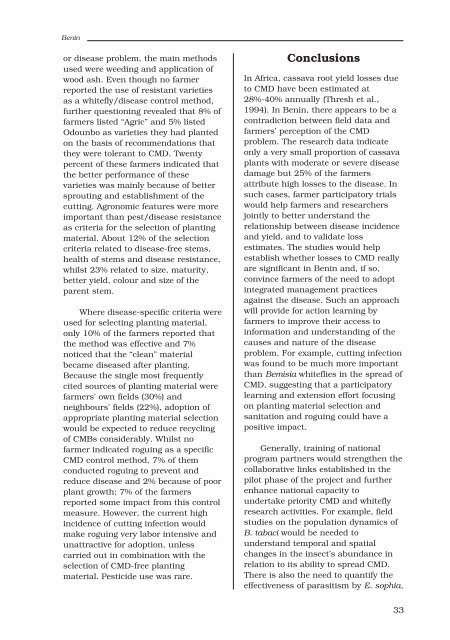Whitefly and whitefly-borne viruses in the tropics : Building a ... - cgiar
Whitefly and whitefly-borne viruses in the tropics : Building a ... - cgiar
Whitefly and whitefly-borne viruses in the tropics : Building a ... - cgiar
Create successful ePaper yourself
Turn your PDF publications into a flip-book with our unique Google optimized e-Paper software.
Ben<strong>in</strong><br />
or disease problem, <strong>the</strong> ma<strong>in</strong> methods<br />
used were weed<strong>in</strong>g <strong>and</strong> application of<br />
wood ash. Even though no farmer<br />
reported <strong>the</strong> use of resistant varieties<br />
as a <strong>whitefly</strong>/disease control method,<br />
fur<strong>the</strong>r question<strong>in</strong>g revealed that 8% of<br />
farmers listed “Agric” <strong>and</strong> 5% listed<br />
Odounbo as varieties <strong>the</strong>y had planted<br />
on <strong>the</strong> basis of recommendations that<br />
<strong>the</strong>y were tolerant to CMD. Twenty<br />
percent of <strong>the</strong>se farmers <strong>in</strong>dicated that<br />
<strong>the</strong> better performance of <strong>the</strong>se<br />
varieties was ma<strong>in</strong>ly because of better<br />
sprout<strong>in</strong>g <strong>and</strong> establishment of <strong>the</strong><br />
cutt<strong>in</strong>g. Agronomic features were more<br />
important than pest/disease resistance<br />
as criteria for <strong>the</strong> selection of plant<strong>in</strong>g<br />
material. About 12% of <strong>the</strong> selection<br />
criteria related to disease-free stems,<br />
health of stems <strong>and</strong> disease resistance,<br />
whilst 23% related to size, maturity,<br />
better yield, colour <strong>and</strong> size of <strong>the</strong><br />
parent stem.<br />
Where disease-specific criteria were<br />
used for select<strong>in</strong>g plant<strong>in</strong>g material,<br />
only 10% of <strong>the</strong> farmers reported that<br />
<strong>the</strong> method was effective <strong>and</strong> 7%<br />
noticed that <strong>the</strong> “clean” material<br />
became diseased after plant<strong>in</strong>g.<br />
Because <strong>the</strong> s<strong>in</strong>gle most frequently<br />
cited sources of plant<strong>in</strong>g material were<br />
farmers’ own fields (30%) <strong>and</strong><br />
neighbours’ fields (22%), adoption of<br />
appropriate plant<strong>in</strong>g material selection<br />
would be expected to reduce recycl<strong>in</strong>g<br />
of CMBs considerably. Whilst no<br />
farmer <strong>in</strong>dicated rogu<strong>in</strong>g as a specific<br />
CMD control method, 7% of <strong>the</strong>m<br />
conducted rogu<strong>in</strong>g to prevent <strong>and</strong><br />
reduce disease <strong>and</strong> 2% because of poor<br />
plant growth; 7% of <strong>the</strong> farmers<br />
reported some impact from this control<br />
measure. However, <strong>the</strong> current high<br />
<strong>in</strong>cidence of cutt<strong>in</strong>g <strong>in</strong>fection would<br />
make rogu<strong>in</strong>g very labor <strong>in</strong>tensive <strong>and</strong><br />
unattractive for adoption, unless<br />
carried out <strong>in</strong> comb<strong>in</strong>ation with <strong>the</strong><br />
selection of CMD-free plant<strong>in</strong>g<br />
material. Pesticide use was rare.<br />
Conclusions<br />
In Africa, cassava root yield losses due<br />
to CMD have been estimated at<br />
28%-40% annually (Thresh et al.,<br />
1994). In Ben<strong>in</strong>, <strong>the</strong>re appears to be a<br />
contradiction between field data <strong>and</strong><br />
farmers’ perception of <strong>the</strong> CMD<br />
problem. The research data <strong>in</strong>dicate<br />
only a very small proportion of cassava<br />
plants with moderate or severe disease<br />
damage but 25% of <strong>the</strong> farmers<br />
attribute high losses to <strong>the</strong> disease. In<br />
such cases, farmer participatory trials<br />
would help farmers <strong>and</strong> researchers<br />
jo<strong>in</strong>tly to better underst<strong>and</strong> <strong>the</strong><br />
relationship between disease <strong>in</strong>cidence<br />
<strong>and</strong> yield, <strong>and</strong> to validate loss<br />
estimates. The studies would help<br />
establish whe<strong>the</strong>r losses to CMD really<br />
are significant <strong>in</strong> Ben<strong>in</strong> <strong>and</strong>, if so,<br />
conv<strong>in</strong>ce farmers of <strong>the</strong> need to adopt<br />
<strong>in</strong>tegrated management practices<br />
aga<strong>in</strong>st <strong>the</strong> disease. Such an approach<br />
will provide for action learn<strong>in</strong>g by<br />
farmers to improve <strong>the</strong>ir access to<br />
<strong>in</strong>formation <strong>and</strong> underst<strong>and</strong><strong>in</strong>g of <strong>the</strong><br />
causes <strong>and</strong> nature of <strong>the</strong> disease<br />
problem. For example, cutt<strong>in</strong>g <strong>in</strong>fection<br />
was found to be much more important<br />
than Bemisia whiteflies <strong>in</strong> <strong>the</strong> spread of<br />
CMD, suggest<strong>in</strong>g that a participatory<br />
learn<strong>in</strong>g <strong>and</strong> extension effort focus<strong>in</strong>g<br />
on plant<strong>in</strong>g material selection <strong>and</strong><br />
sanitation <strong>and</strong> rogu<strong>in</strong>g could have a<br />
positive impact.<br />
Generally, tra<strong>in</strong><strong>in</strong>g of national<br />
program partners would streng<strong>the</strong>n <strong>the</strong><br />
collaborative l<strong>in</strong>ks established <strong>in</strong> <strong>the</strong><br />
pilot phase of <strong>the</strong> project <strong>and</strong> fur<strong>the</strong>r<br />
enhance national capacity to<br />
undertake priority CMD <strong>and</strong> <strong>whitefly</strong><br />
research activities. For example, field<br />
studies on <strong>the</strong> population dynamics of<br />
B. tabaci would be needed to<br />
underst<strong>and</strong> temporal <strong>and</strong> spatial<br />
changes <strong>in</strong> <strong>the</strong> <strong>in</strong>sect’s abundance <strong>in</strong><br />
relation to its ability to spread CMD.<br />
There is also <strong>the</strong> need to quantify <strong>the</strong><br />
effectiveness of parasitism by E. sophia,<br />
33
















